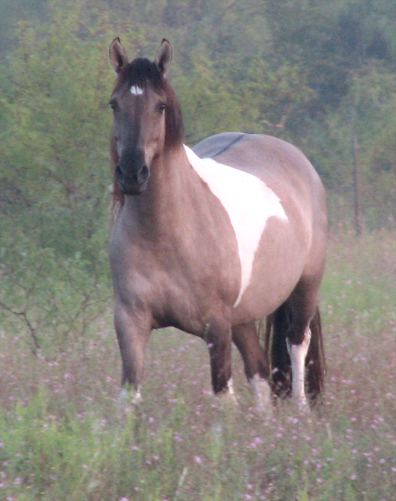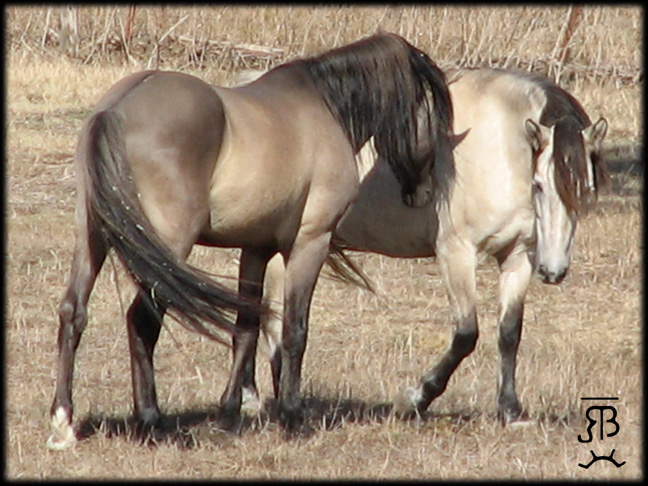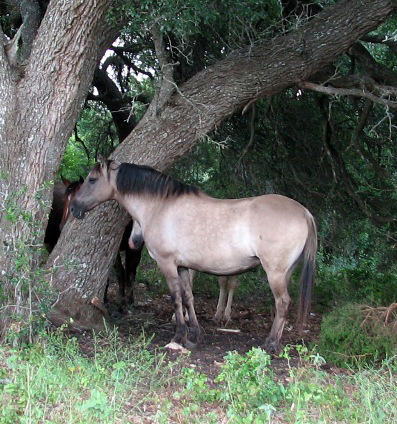Email: kigers@ranchobayo.com
rancho bayo © 2012 located in central texas usa 512.868.7638
Double click here to edit this text.
We cherish our mares...we hold a deep bond with each of them and they are the foundation for the next generation. After careful selection and earning the right to help produce the future, a lot of care goes into choosing the right stallion for them and making sure they have the best advantages over the years to come.
Breeding our Mares
For the most part, we prefer to breed our mares to our home stallions. This is true 100% of the time with a maiden mare as I feel that this natural breeding is the best introduction a mare can have to her new life as a momma. We carefully train our stallions to be gentlemen and they are not allowed any offensive behavior. The time is taken to cover the mares in a calm manner when they are ready. We watch their heat cycles and tease them naturally so they let us know when they are ready to be covered. This avoids injuries and bad attitudes that can develop when trying to breed a mare that is not ready; they are never forced, boxed in or hobbled.
Up to the actual breeding, our mares are acclimated to the stallion they are to be bred to so they get to know him. Many times they are stalled next to each other or the stallion is put in a safe area where the mares can come up and visit with him during the day. Often we bring the mare over to the stallion for a visit each night so they can snuff noses and talk to each other in a safe situation.
Breeding our Mares
For the most part, we prefer to breed our mares to our home stallions. This is true 100% of the time with a maiden mare as I feel that this natural breeding is the best introduction a mare can have to her new life as a momma. We carefully train our stallions to be gentlemen and they are not allowed any offensive behavior. The time is taken to cover the mares in a calm manner when they are ready. We watch their heat cycles and tease them naturally so they let us know when they are ready to be covered. This avoids injuries and bad attitudes that can develop when trying to breed a mare that is not ready; they are never forced, boxed in or hobbled.
Up to the actual breeding, our mares are acclimated to the stallion they are to be bred to so they get to know him. Many times they are stalled next to each other or the stallion is put in a safe area where the mares can come up and visit with him during the day. Often we bring the mare over to the stallion for a visit each night so they can snuff noses and talk to each other in a safe situation.



Only when the mare is ready and willing, do we allow the breeding. Many maiden mares are hand held, along with the stallion, so we can assist in creating positive behavior or take the stallion away if the mare decides she's just not ready. Sometimes a new mare or an outside mare that has been previously bred and had a bad experience gets nervous or defensive about being bred. When this happens, we have to focus all of our attention on the mare and usually we turn Charro loose as he is savvy to dealing with difficult mares. This allows us to help the mare along as Charro woos her with little touches, rubs and kisses. He knows best how to convince a mare that this whole situation is a good idea. He knows when she is ready and will make his move. This situation has shown mares that breeding is not a negative experience and often times we then turn the mare loose with Charro and they buddy up for the day with the mare following him around with adoration.
Some times with mares we know, we let the mare and stallion spend time together when she is in heat so they can breed naturally. We believe this is the best situation and gives the best outcome for conceiving a foal. This also allows for more natural behavior that we believe is not only healthy for all involved, but essential for their well being and well being for the newly created life.
Some times with mares we know, we let the mare and stallion spend time together when she is in heat so they can breed naturally. We believe this is the best situation and gives the best outcome for conceiving a foal. This also allows for more natural behavior that we believe is not only healthy for all involved, but essential for their well being and well being for the newly created life.

Our Mares and outside Stallions
At times, we use outside stallions for breeding our mares and it is necessary to do artificial insemination (AI). While this is not the best situation we do try to make the best of it. We prefer to use mares that have had a few foals conceived naturally because I believe this creates a healthier and more viable situation for introduction to the new sperm which also has chemical extenders added to it for shipping. We also prefer that the vet come to our ranch to do the insemination, this way our mares are at home in a comfortable environment and the stress is lessened.
With some of the more confident and experienced mares, I may take them the short ride to the vet daily for ultra sounding and to be bred, but I do not leave them there. I believe there can be ill-effects on the new life being conceived under stress. I have experienced this in the past when I have left mares at breeding facilities or vet offices and we have had issue with getting the mare to conceive or later she has lost the fetus. At a breeding facility or a vet, the goal is to get the job done and that attitude is not always conducive to helping the mare feel comfortable and relaxed. I have found this to be particularly true with the wild mares...they do much better at home.
At times, we use outside stallions for breeding our mares and it is necessary to do artificial insemination (AI). While this is not the best situation we do try to make the best of it. We prefer to use mares that have had a few foals conceived naturally because I believe this creates a healthier and more viable situation for introduction to the new sperm which also has chemical extenders added to it for shipping. We also prefer that the vet come to our ranch to do the insemination, this way our mares are at home in a comfortable environment and the stress is lessened.
With some of the more confident and experienced mares, I may take them the short ride to the vet daily for ultra sounding and to be bred, but I do not leave them there. I believe there can be ill-effects on the new life being conceived under stress. I have experienced this in the past when I have left mares at breeding facilities or vet offices and we have had issue with getting the mare to conceive or later she has lost the fetus. At a breeding facility or a vet, the goal is to get the job done and that attitude is not always conducive to helping the mare feel comfortable and relaxed. I have found this to be particularly true with the wild mares...they do much better at home.
340 days until Foaling!
Once the mares are covered, extra care is taken not to stress or especially add any chemical into the body. For the first week or so, the newly conceived fetus is very vulnerable until it attaches to the uterine wall. Stress or unnatural influences, such as dewormer, can cause this to not happen. For the first 60 days after conception, the internal organs of the fetus are being formed...this is another time where the introduction to chemicals can affect development and possibly problems later on in life.
We add no undue stress to our mares during their pregnancy. Fear can cause adrenaline to be released into the body and to the fetus and this can affect the temperament of the foal after it is born. A nervous mare can produce nervous foals because of the chemical dependency the fetus gets before birth. It can also produce foals that go the other way and ignore stimulus, making them harder to deal with because they are indifferent to things.
Mares are kept in their mare herd while they have foals at their sides and have been rebred. After the foals are weaned, the collective mares go back onto the 100 acres and rejoin the Wild Bunch. This helps keep them get back to a more natural state and keeps them fit during the middle of their pregnancy. They get the benefit of daily traveling, up and down hills, through creeks and meadows, all while being able to forage and eat the variety their bodies need. A daily feeding of whole oats is available for added protein and fat; plus varied types of salts and minerals. Many times we bury them so the mares can naturally dig them up..
Once the mares are covered, extra care is taken not to stress or especially add any chemical into the body. For the first week or so, the newly conceived fetus is very vulnerable until it attaches to the uterine wall. Stress or unnatural influences, such as dewormer, can cause this to not happen. For the first 60 days after conception, the internal organs of the fetus are being formed...this is another time where the introduction to chemicals can affect development and possibly problems later on in life.
We add no undue stress to our mares during their pregnancy. Fear can cause adrenaline to be released into the body and to the fetus and this can affect the temperament of the foal after it is born. A nervous mare can produce nervous foals because of the chemical dependency the fetus gets before birth. It can also produce foals that go the other way and ignore stimulus, making them harder to deal with because they are indifferent to things.
Mares are kept in their mare herd while they have foals at their sides and have been rebred. After the foals are weaned, the collective mares go back onto the 100 acres and rejoin the Wild Bunch. This helps keep them get back to a more natural state and keeps them fit during the middle of their pregnancy. They get the benefit of daily traveling, up and down hills, through creeks and meadows, all while being able to forage and eat the variety their bodies need. A daily feeding of whole oats is available for added protein and fat; plus varied types of salts and minerals. Many times we bury them so the mares can naturally dig them up..
